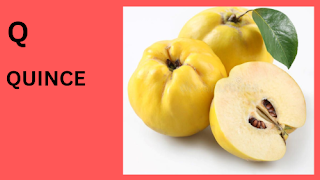Health Benefits of Eating Quince Fruits.
Health Benefits of Eating Quince Fruits.
The post introduces Quince fruit as its medical values have been recognised since traditional times and describes its nutrition and significant health values.
This post is for the letter Q of the Blog chatter's A2Z writing challenge in April and for P here.
How many of you have heard of this fruit, let alone seen it? After reading about it, I feel embarrassed for not paying attention to this beautiful fruit; that might only have happened if my search for a fruit starting with the letter Q hadn't happened. It is constantly in my grocery stores and has been there for centuries as a staple food in various cultures.
The fruit has always been noted for its medicinal purposes and was cultivated in ancient Babylon. In Greece, Quince was sacred to the goddess of love, Aphrodite. Greek brides chewed a piece of Quince to get sweet-smelling breadth before entering the bridal chamber. The Romans, who continued the Greek tradition, gave Quince to couples to dine with to symbolise good luck.
Nutritional contents.
One quince fruit, about 92 grams, contains the following nutrients.
- Calories: 52,4.
- Carbohydrates: 14,1 grams.
- Protein: 0,4 grams.
- Fat: 0,1 grams.
- Dietary fibre: 1,79 grams.
- Vitamin C: 13,8 mg, 23 % of the Daily Value.
- Potassium: 181 mg (5% of the DV)
- Copper: 0,1 mg (6% of DV)
- Magnesium: (7,4 mg 2% DV)
- Phosphorous: 15,6 mg (2% DV)
- Quince also contains tiny amounts of vitamin A, thiamine, niacin, pantothenic acid, calcium, and Selenium.
Health Benefits.
1. Rich in antioxidants.
Eating Quince, a significant source of antioxidant, help neutralise disease-causing free radicals and protect against chronic diseases.
2. It May help digestion and reduce constipation.
Recent research studies confirmed the medical uses of fruit and seeds to help relieve constipation and support regularity in agreement with the traditional knowledge.
3. Fight bacteria.
Studies show extracts of the fruit and seeds could help protect against several strains of pathogenic bacteria than can cause infection and illness in humans.
4. Promote heart health.
Research has confirmed that fruit help supports better heart health.
5. Support wound healing.
Recent studies have shown that the fruit possesses potent heart-healing properties.
6. Help relieve Gastroesophageal reflux disease.
It occurs when stomach acid flows back to the oesophagus, causing symptoms like heartburn, nausea, and belching.
Downslides.
One big challenge in eating the fruit is the prior preparation. Because of its odd shape and firm flesh, it is difficult to cut up. Even when fully ripe, the fruit is inedible.
It needs to be cooked to soften up, which gives it a sweet flavour and tender texture. It is difficult to find near your supermarket.
Eating the fruit can cause side effects such as etching, wheezing, or hives. In that case, stop eating and approach your doctor. Additionally, it is essential not to take your medication with the fruit; take it an hour after.
How to prepare fruit for eating?
- Cut the fruit into quarters.
- Remove the core and the seeds.
- Slice off any soft spots.
- Fill a saucepan with water and bring to a boil.
- Add the fruit and let it simmer for 40-50 minutes until it becomes tender.
Conclusion:
The post introduces Quince fruit as its medical values were recognised traditionally and describes its nutrition and significant health values.
Have you eaten this fruit? If so, how was your eating experience?
This post is for the letter Q in the series of my A2Z blog posts, lasting for the entire month and is part of the A2Z Blog chatter challenge. To read earlier posts, click on these letters. A B C D E F G H I J K L M N O P
*



Your article on the health benefits of eating quince was fantastic! The way you presented the nutritional information and highlighted the various ways in which quince can benefit our health was very engaging.
ReplyDelete